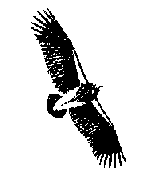

Order: Ciconiiformes Family:
Accipitridae
Scientific name: Torgos tracheliotus or Aegypius
tracheliotus U.S. common name: Lappet-faced vulture
Status in the wild: Uncommon resident, except in
Namibia and southern Zimbabwe where they are common
Major threats: Human encroachment and
habitat loss
Geographic range currently: Arid parts of Africa from
southern Sahara east to Sudan and Ethiopia, south through Kenya, Tanzania to
South Africa and
west to the Namib Desert.
Habitat: Semi-arid and desert scrub
regions. Also wooded grasslands and plains.
Circadian cycle: Diurnal
Size
General range male female birth
Tarsus: 134-144
mm
Weight: 5.4-13.9 kg
6.5-9.2 kg 10.5-13.9 kg 180-200
g
Sexual dimorphism: Females are slightly larger than males
(~5%).
Reproduction
Mating Season: May to September
Incubation period: 53-56 days
Courtship: Courtship flights are unknown
and possibly unnecessary if the pair remains together throughout the year.
Copulation: Is unobtrusive at the nest or
in a tree and accompanied by a shrill whistling call. The male will grip the
female’s ruff. Sometimes both birds
perform a head-and-neck
twist before and after the act.
Sexual maturity: At least 6 years of age for
both sexes.
Other information: Nests are built at the top of
short trees. Heights above the ground range from 3-15 meters. The nest
themselves can be up to 2.2 m in
diameter
and 0.7 m thick. They are constructed of from non-thorny sticks and both birds
help in construction. Nests are saucer shaped
and the
central depression is 0.7-1.0 meters in diameter and is well lined with short
dried grass. Pairs may make a new nest each year or
may reuse
the one previously.
Rearing and
young
Young called: Chicks
Number of eggs (range): One, rarely two
Condition of young: Altricial
Eyes open: At hatching
Fledging: At about 4 months.
General
Social structure: Adults are usually seen in
pairs although they may be solitary. Adults are seen more frequently in pairs
than alone.
Unique behavior(s): When feeding it flies to a
fresh carcass, cuts it open, and eats first. It holds the body down with the
feet to tear off chunks with its beak.
Then it
goes to outskirts and attacks other vultures, snatching flesh from them. When
threatening others, this vulture runs forward with
head
lowered, neck outstretched, feathers of back erect, and wings spread. Unable to
fly far without aid of thermal currents in flat land.
In
mountains can ride updrafts. Normally entirely silent but can emit hisses,
yelps, and grunts.
Senses: Locate food by sight rather
than smell. Watch other birds in area who feed on carrion.
Coloration: Has a naked pink head and
neck with ear-like lappets. Beak may be dusky or yellow. There is a short brown
ruff; dark brown back, wings, and a
short wedge-shaped tail.
The chest has dark stripes; the sides and thighs are white. Flight reveals
black underwings, with a thin white line under
the leading edge.
Diet: This bird relies almost
entirely on carrion, although it has been known to kill adult and young
flamingos, and to eat eggs, termites and locusts.
Sources
Mundy,
P., Butchart, D., Ledger, J. and Piper, S. 1992. The Vultures of Africa.
Academic Press Limited, London.
Alden,
Peter C. et al. 1995. National Audubon
Society Field Guide to African Wildlife.
Alfred A. Knopf, Inc., New York.